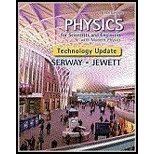
(a)
The distance between the water surface and the bottom face of the block.
(a)
Answer to Problem 85CP
The distance between the water surface and the bottom face of the block is
Explanation of Solution
The ice cube is floating in a glass of ice cold water. According to Archimedes principle the upward buoyant force exerted on the ice cube by the ice cold water is equal to the weight of the ice cold water displaced.
Here,
Write the expression for the buoyant force exerted by the ice cold water on ice.
Here,
One of the surface of the ice is parallel to the surface of the water. So dimension of ice cube and water are same.
Write the expression for volume of water in terms of the height and edge length.
Here,
Write the expression for the surface area of water surface.
Here,
Use expressions (IV) in (III).
Use expression (V) in (II) to find
Write the expression for the weight of ice.
Here,
Write the expression for the mass of ice in terms of volume and density.
Here,
Use expression (VIII) in (VII).
Use expressions (VI) and (IX) in expression (I) to find
Conclusion:
Substitute
Therefore, the distance between the water surface and the bottom face of the block is
(b)
The distance from the top of the water to the bottom face of the block.
(b)
Answer to Problem 85CP
The distance from the top of the water to the bottom face of the block is
Explanation of Solution
Alcohol is poured on top of the water surface so that it forms a layer above the water. After attaining hydrostatic equilibrium also the top of cube is still above the alcohol.
Again apply Archimedes principle. That is the sum of buoyant force exerted by the water surface and alcohol surface is equal to the weight of the ice.
Here,
Write the expression for buoyant force exerted by alcohol.
Here,
Use expressions (XII), (IX) and (VI) in expression (XI) and solve for
Conclusion:
Substitute
Therefore, the distance from the top of the water to the bottom face of the block is
(c)
The thickness of ethyl alcohol required to cause complete coinciding of top surface of ice cube with alcohol layer.
(c)
Answer to Problem 85CP
A thickness of ethyl alcohol required to cause complete coinciding of top surface of ice cube with alcohol layer is
Explanation of Solution
The ethyl alcohol is added to the surface of water. Thus height of the water layer will be modified. Apply Archimedes principle. The sum of buoyant force exerted by the water and alcohol layer after the addition of ethyl alcohol.
Here,
Write the expression for the new height of water layer.
Here,
Write the expression for the buoyant force exerted by the alcohol layer.
Write the expression for the buoyant force exerted by the water layer after addition of ethyl alcohol.
Use expressions (XVII), (XVI), and (IX) in expression (XIV) and solve for
Conclusion:
Substitute
Therefore, the thickness of ethyl alcohol required to cause complete coinciding of top surface of ice cube with alcohol layer is
Want to see more full solutions like this?
Chapter 14 Solutions
Bundle: Physics for Scientists and Engineers with Modern Physics, Loose-leaf Version, 9th + WebAssign Printed Access Card, Multi-Term
- (a) For a spherical capacitor with inner radius a and outer radius b, we have the following for the capacitance. ab C = k₂(b- a) 0.0695 m 0.145 m (8.99 × 10º N · m²/c²)( [0.145 m- 0.0695 m × 10-11 F = PF IIarrow_forwardA pendulum bob A (0.5 kg) is given an initialspeed of vA = 4 m/s when the chord ishorizontal. It then hits a stationary block B (1kg) which then slides to a maximum distanced before it stops. Determine the value of d.The coefficient of static friction between theblock and the plane is μk = 0.2. The coefficientof restitution between A and B is e = 0.8.Ans: d=1.0034 marrow_forwardFigure 29-43 Problem 12. ••13 In Fig. 29-44, point P₁ is at distance R = 13.1 cm on the perpendicular bisector of a straight wire of length L = 18.0 cm carrying current i = 58.2 mA. (Note that the wire is not long.) What is the magnitude of the magnetic field at P₁ due to i? P2° R R Larrow_forward
- Checkpoint 1 The figure shows the current i in a single-loop circuit with a battery B and a resistance R (and wires of neg- ligible resistance). (a) Should the emf arrow at B be drawn pointing leftward or rightward? At points a, B C R b, and c, rank (b) the magnitude of the current, (c) the electric potential, and (d) the electric potential energy of the charge carriers, greatest first.arrow_forwardPls help ASAParrow_forwardPls help asaparrow_forward
 Principles of Physics: A Calculus-Based TextPhysicsISBN:9781133104261Author:Raymond A. Serway, John W. JewettPublisher:Cengage Learning
Principles of Physics: A Calculus-Based TextPhysicsISBN:9781133104261Author:Raymond A. Serway, John W. JewettPublisher:Cengage Learning Physics for Scientists and Engineers, Technology ...PhysicsISBN:9781305116399Author:Raymond A. Serway, John W. JewettPublisher:Cengage Learning
Physics for Scientists and Engineers, Technology ...PhysicsISBN:9781305116399Author:Raymond A. Serway, John W. JewettPublisher:Cengage Learning Physics for Scientists and Engineers: Foundations...PhysicsISBN:9781133939146Author:Katz, Debora M.Publisher:Cengage Learning
Physics for Scientists and Engineers: Foundations...PhysicsISBN:9781133939146Author:Katz, Debora M.Publisher:Cengage Learning Physics for Scientists and Engineers with Modern ...PhysicsISBN:9781337553292Author:Raymond A. Serway, John W. JewettPublisher:Cengage Learning
Physics for Scientists and Engineers with Modern ...PhysicsISBN:9781337553292Author:Raymond A. Serway, John W. JewettPublisher:Cengage Learning University Physics Volume 1PhysicsISBN:9781938168277Author:William Moebs, Samuel J. Ling, Jeff SannyPublisher:OpenStax - Rice University
University Physics Volume 1PhysicsISBN:9781938168277Author:William Moebs, Samuel J. Ling, Jeff SannyPublisher:OpenStax - Rice University College PhysicsPhysicsISBN:9781285737027Author:Raymond A. Serway, Chris VuillePublisher:Cengage Learning
College PhysicsPhysicsISBN:9781285737027Author:Raymond A. Serway, Chris VuillePublisher:Cengage Learning





